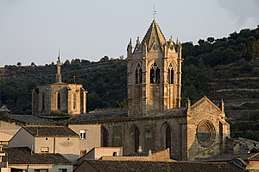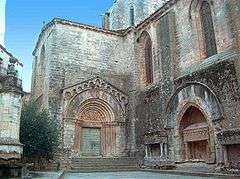Monastery of Santa Maria de Vallbona
The Monastery of Santa Maria de Vallbona (Catalan Santa Maria de Vallbona de les Monges; Spanish El Real Monasterio de Santa María de Vallbona) is a Cistercian abbey in Vallbona de les Monges, in the comarca of Urgell, Catalonia, Spain. Founded in the early 12th century, it is one of the most important monasteries in Catalonia; its church represents an example of transition between Romanesque and Gothic architecture. The abbey was declared a national monument in 1931.

History
Initially the monastery consisted in a community of hermits, documented from 1157, which followed the Benedictine rule; in 1175, however, only a small group of nuns remained. In 1163 they had received territories from Ramon Berenguer IV, count of Barcelona, and in that year decided to switch to the Cistercian order. Two years later the abbey received several privileges from King Alfonso I of Aragon, and subsequently it could expand thanks to the numerous donations from noble families. Other privileges came from bulls issued by Pope Innocent III in 1198, 1200 and 1201.
In the 12th-14th centuries the monastery created a true fiefdom across the county of Urgell, which was legally confirmed when abbess Saurena de Anglesola (1379–1392) bought the civil and criminal jurisdiction over these lands from King Peter III of Aragon. At the time there were some 150 nuns in the abbey, most of Catalan noble origin.
The Catalan Civil War (1462–1472) and later the Council of Trent (1545–1563) had a deep impact over the monastery. The latter issued a law by which female communities in uninhabited places were forbidden, which forced the nuns to sell several of their lands (1573) to colonists who could form a settlement around the monastery. This settlement later evolved in the current town of Vallbona de las Monges. In the following centuries, strife with the monastery of Santa Maria de Poblet, and events such as the Catalan Revolt (1640–1652), the War of Spanish Succession (1705–1717) and the War of the Pyrenees (1788–1795), eroded the economic prosperity of the abbey. The monastery is still a functioning abbey, but is open to visitors daily.

Architecture
The church
The church, built in the 12th-14th centuries in a transitional style between the Romanesque and the Gothic, has a Latin cross plan with a single nave including four aisles, and a transept. The latter is longer but narrower than the nave, to which it is connected by a rectangular shape surmounted by an octagonal dome, supported by 13th century squinches. The transept's arm end with square apse chapels. The nave is covered by cross vaults, while the transept has barrel vaults.
The bell tower, built in 1340-1348, has an octagonal plan. It is in Gothic style. The presbytery houses the sepulchre of Violant of Hungary, wife of King James I of Aragon, who died in 1251 and whose remains were brought here in 1275. To the right of the choir is the Corpus Christi Chapel, which has a polychrome stone image of Mary, work of Guillem Seguer.
Gates
The main gate is located in the northern transept arm and faces the monastery's square. It features five archivolts supported by columns and capitals with foliate reliefs and a tympanum sculpted with the Virgin and Child, surrounded by angels. Above the latter is a decorated frieze.
Another gate is located on the church's northern wall, but is now obstructed by a sarcophagus enclosed in an ogival arch. This wall has a total of five sarcophagi, four in Romanesque style (13th century) and one in Gothic style.
Cloister
The cloister is on a quadrangular plan, whose sides, of different lengths, correspond to different, successive ages and construction styles (12th-15th centuries). The oldest sector, on the south, shows the original, sober Romanesque-Cistercian canons: it has three spans formed by three piers, with three rounded arcades supported by columns with undecorated capitals.
The eastern wing is also in Romanesque style (early 13th century), and has five spans divided by four pilasters, The arcades form triple mullioned windows with, in the mullions, small rose windows with decoration in Arabic style. The capitals of the columns have vegetable motifs.
The northern wing is the shortest one; it has wide hollows with ogival traceries in Gothic style, dating to the 14th century. The western side, the most recent one, was built in the 15th century in proto-Renaissance style. The capitals of the columns show the heraldic symbols of the Caldés family, who produced the monastery's abbesses during that period.
The Capitular Hall is accessed from the cloister through a Gothic gate built under abbess Anglesola in the 14th century, and has a cross-vault cover. The pavement features several tomb slabs of abbesses, and there is an alabaster image of the Virgin of Mercy, attributed to the sculptor Pere Johan.
| Wikimedia Commons has media related to Monestir de Santa Maria de Vallbona. |
Sources
- Gonzalvo i Bou, Gener; Josep Maria Sans i Trave (1998). Vallbona, Guía Histórico-Artística. Milenio Editorial. ISBN 84-89790-28-0.